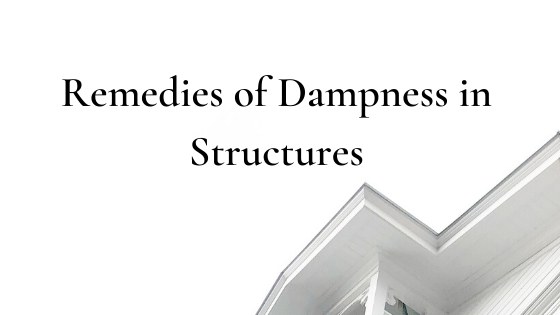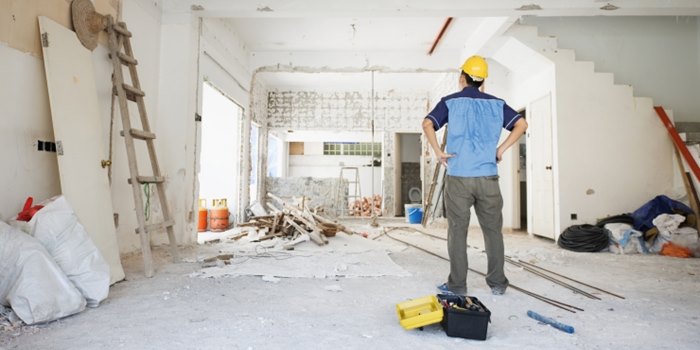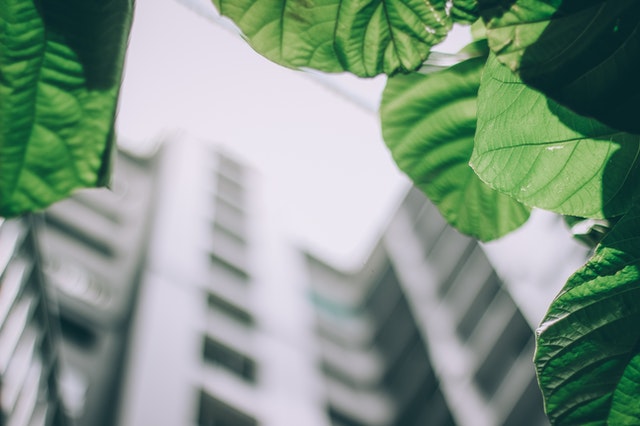One of the basic requirements of all the buildings is that it should remain as dry as possible. When dampness enters the building, the building may become inhabitable and unsafe.
The treatment given to the buildings to prevent the entry of damp (moisture) is called Damp-proofing.
Causes of Dampness
The various causes which are responsible for the dampness in the buildings are as follows:
- Rising of moisture from the ground
- Action of Rain
- The exposed top of walls
- Inadequate roof slope
- Defective junctions of building components
- Condensation
- Poor material quality
- Earth banked against the walls
- Orientation of building
Effects of Dampness
The various effects of dampness are as follows:
- In the damp buildings, the mosquitos and bacteria can breed and cause various disease to the occupants.
- Metals used in the building get corroded.
- The unsightly patches are formed on the walls and the ceilings.
- Softening and crumbling of plaster and finishes. It leads to difficult and costly repairs.
- Risk of leakage of electricity and short-circuiting.
Remedies of Dampness
There are two types of remedies to eradicate this evil from the buildings:
- Temporary remedies
- Permanent remedies
The temporary remedies are used to removing and hiding the dampness for the short interval of the time period and mainly used for the old buildings.
The permanent remedies are used to remove the dampness permanently from old buildings as well as while constructing the buildings.
Temporary Remedies for Internal Portions
These low-cost temporary methods can be adopted as a short term measure:
1. Bituminised Paper:
Mostly in ordinary buildings bituminised paper should be pasted on the wall because bitumen paper is tough and partially non-absorbent and it will remove the difficulty of hanging clothes on the walls while pasting normal paper on the wall behind these clothes on the damp portions.
2. Tinfoil:
Tin foils can be pasted on the walls with strong adhesive on the walls at damp portions. It is totally damp proof and checks the movement of moisture. The only care is to paste it correctly with good adhesive.
3. Damp-proofing whitewash:
The damp proofing for ordinary walls is done with the following composition;
Soak 8 kg of best whitening in 4.5 litres of boiling water until it can be beaten up into semi-liquid consistency. Add to this 150 gm phosphate of soda dissolved in a small quantity of boiling water. Now add 300 gm white glue after dissolving it in boiling water. Stir and obtain a smooth paste for whitewashing.
4. Waterproofing solutions:
It can prevent the penetration of moisture in the walls. It is mixed in the cement mortar before plastering. Sometimes the solution can be simply applied on the damp surface with the brush. The damp wall should be dried before applying this and cracks, nail holes other repairs must be done by plaster of Paris.
- The canvas can be fixed on a timber batten frame fixed to the wall to conceal the damp walls.
- Glazed tiles can be used for bathrooms, kitchens, halls by fixing them with cement paste on the walls.
Temporary Remedies for External Walls
1. Waterproofing solutions:
It is used for both internal as well as for the external walls to remove the dampness.
2. Lead paints:
The buildings are washed with leads paints so that water can’t penetrate them. Before application of this paint, the cement plaster must be allowed to weather by exposing it to sun and rain at least for twelve months.
- Zinc paints can be used for external walls.
- Boiled linseed oil:
The wall should be dried before the application of this oil and 2 to 3 coats will prevent the penetration of moisture in the walls.
3. Paraffin wax:
It is better to dissolve this wax in the kerosene oil instead of direct application of wax. After application, the kerosene oil will evaporate leaving a continuous member of solid paraffin on the surface of bricks.
Permanent Remedies of Dampness
There are various methods which give permanent remedies against dampness which are as follows:
1. Surface Treatment:
The walls can be prevented by dampness in the areas of the rainfall by the surface treatment. It is of two types. In one the pores of the exposed walls and materials are filled by providing a thin film of water repellent material over the surface. In the second type weather tiles, slates, iron and corrugated sheets are fixed over the walls which protect it from the wall which protect it from the direct hit of rain.
The materials that can be used are sodium or potassium silicate, coal tar or bitumen, barium hydroxide, lime plaster, decorative waterproof cement coating.
2. Integral water-proofing
To make concrete repellent sometimes calcium, sodium, ammonium stearates and oleates and petroleum oil are used to make the concrete or mortar denser so that moisture cannot pass through them. These chemicals react chemically and make the materials water-proof added in the small amount in the cement mortar or concrete.
3. Damp proof course
In new buildings or old buildings for the permanent remedy of dampness, a layer of water repellent material is introduced, which acts as a barrier against the travel of damp. These water repellent material layers are called damp-proof courses. This method is known as membrane interposing method.
DPC Materials
There are various types of materials available which can be used for removal of dampness. Some of the most common materials are given below:
- Rigid Materials: Stone slates, special bricks, cement concrete blocks, dense cement concrete, terra-cotta blocks, hollows tiles etc.
- Flexible Materials: Metal sheets, plastic sheets, bituminous sheets, P.V.C. sheets etc.
Dampness is a great evil so the eradication of it is a must. It should be removed timely to reduce the various problems in the near future. The remedies which have been described above include both temporary and permanent can be used for the eradication of this evil.
Also Read: Termite Control in Buildings



https://waterfallmagazine.com
I’m not that much of a online reader to be honest but your sites really nice, keep it up!
I’ll go ahead and bookmark your site to come back later on. Many thanks
Thank you very much.
Your words mean a lot to us.